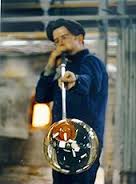After the invention of the blowpipe around the beginning of the Christian era by the Syrians could bottles and glass get shape.
Only around 1650 people started to store wine in bottles. With a straw cloak protected flagons were called a fiasco in Italy.
The first cylindrical bottles that you can stack flat, we only see around 1750. Since glass is a poor conductor of heat, a bottle cannot be made at once. Halfway through the production process, the internal heat must be given an opportunity to get to the outside, which is cooled by contact with the metal bottle shape, to go back to operating temperature. Bottles and jars machines therefore have a 'pre form', in which the product is given a provisional model. Thereafter, it is formed into a final 'after mold'.
Since glass is a poor conductor of heat, a bottle cannot be made at once. Halfway through the production process, the internal heat must be given an opportunity to get to the outside, which is cooled by contact with the metal bottle shape, to go back to operating temperature. Bottles and jars machines therefore have a 'pre form', in which the product is given a provisional model. Thereafter, it is formed into a final 'after mold'.
You can blow the molten glass on a blowpipe into a bulb or tube. Which can be cut open and flattened. Then it goes into the lehr.
Glass blowing at the furnace is the method with which on a steel (or clay) pipe liquid glass is removed from about 1,130 degrees out of a pot, called “gather”. By swinging the pipe around, the glass will be centered on the pipe. Shaping is done with a (pear) wooden form (the paddle or battledore) and paper, both of which are always wet. It provides a moisture vapor layer, creating a smooth finish.
By the pipe, air is blown in so that the object is growing.
By repeatedly dipping the glass mass becomes larger and the bulb can be blown further.
Behind the pipe is a notch cut. Here later the shape breaks of the pipe.
Before that, the shape is taken with a small piece of hot glass at the bottom to a steel rod (the pontil). The glass blower cools the notch with water. With a tap breaks the shape of the notch. By heating in an oven at 1,200 degrees the material becomes soft again and the opening can be completed. When it is finished it goes into the annealing furnace. The straddling at the pontil under the bottom is polished away later.
